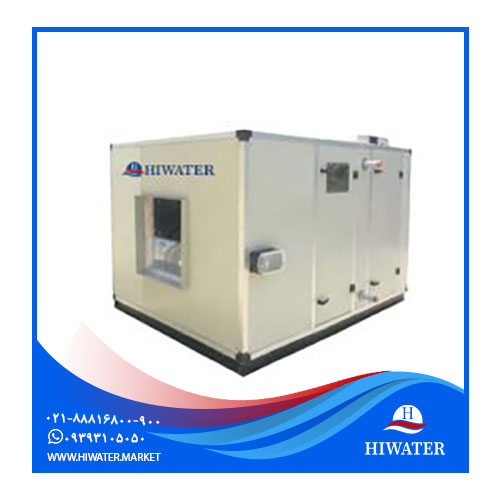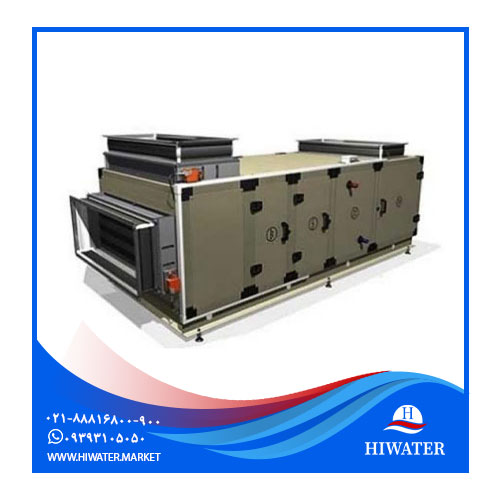Purchasing an Air Handling Unit (AHU)
Purchasing an Air Handling Unit (AHU)
Cost of a Residential Air Handling Unit
Nowadays, air handling systems are considered one of the most efficient solutions for heating and cooling various spaces in buildings and facilities. The price of air handling units is highly economical due to their multifunctionality, providing both heating and cooling while also purifying the air.
⇒To purchase or inquire about air handling unit prices, contact us. Our sales experts will guide you toward a smart purchase. ⇐
Example of a Highwater Air Handling Unit Produced for a Hotel in Shiraz:
Price of Air Handling Units
Example of a Highwater Air Handling Unit with 10,000 CFM capacity:
Example of a Highwater Air Handling Unit with 3,000 CFM capacity:
Components of an Air Handling Unit
Air Box: This section contains cooling coils, heating coils, filters, an air blower, and a fan. It has several air inlets and outlets to ensure proper air supply.
Filters: Filters are used to clean the air and have various types, including metallic and bag filters.
Humidifier: This component uses nozzles to spray water, which moistens the air as dry airflow passes through it.
Control Equipment: Includes hygrometers, thermometers, and control valves.
Coils: Coils are a critical component of air handling units, responsible for adjusting the temperature of incoming air based on the fluid’s temperature. They come in several types like electric coils, chilled water coils, and hot water coils, enabling users to select a coil suitable for their needs.
Electric Motor: The electric motor drives the fan within the air handling unit.
Damper: It is installed at the air intake, regulating the flow of fresh or returned air entering the unit.
Fan or Blower: The fan is a key component of the air handling unit because it pulls in fresh air from the outside. The air then passes through the unit and undergoes filtration, temperature adjustment, and distribution into the desired space. In general, this part is designed to bring fresh air from the outside and channel it into the interior space. Fans come in various types, which can be selected based on specific needs and conditions.
Some Advantages of Using Air Handling Units
The air circulated in the space by the air handling system is rich in oxygen.
They provide easy humidity control using components like humidifiers or dehumidifiers when needed.
They efficiently filter out pollutants and provide cleaner air.
And so on.
Applications of Air Handling Units
Hospitals
Hotels
Sports halls
Various industries
Types of Air Handling Units
Air handling units can be classified based on several factors such as the placement of the fan, functionality, airflow direction, structural design, and appearance. Here, we focus on categorizing them by application, classifying them into three main groups:
Residential Air Handling Units:
Residential AHUs have compact and lower capacity compared to industrial units and are suitable for small spaces such as homes, offices, and commercial and educational facilities. Even though these units offer functionalities like temperature control, humidity adjustment, and air filtration, they typically do not include humidifiers or dehumidifiers unless requested by the customer. In terms of filtration, it is possible to use standard filters that match the needs and circumstances, without requiring costly or highly advanced filters unless absolutely necessary. Here, we will provide a more comprehensive discussion of this product.
Industrial Air Handling Units:
This model of the air handling unit is structurally larger than other types. Consequently, it offers greater capacity and power, allowing it to deliver a large amount of conditioned air. Due to these characteristics, industrial air handling units are widely applicable and can be utilized in extensive areas such as warehouses, manufacturing plants, large industrial workshops, sports facilities, conference halls, and similar spaces.
Hygienic Air Handling Units:
This particular air handling unit is equipped with a sophisticated and expensive filtration system with a robust structure that resists corrosion and rust compared to the other two units, but its design is similar to that of the other types. Hygienic air handling units, due to their advanced filtration capabilities, are designed for use only in environments where maintaining cleanliness is crucial, such as hospitals, laboratories, operating theaters, and pharmaceutical facilities. When examining the filtration process of these units, it operates in three stages: the initial pre-filtration, bag filters, and a powerful, high-performance filtration system. In the final stage, filters like HEPA and ULPA work to eliminate up to 99.99% of air contaminants, including harmful pathogens that may cause diseases.
In the following sections, we will provide more detailed descriptions of each type.
What is a Domestic Air Handling Unit?
Air handling units (AHUs) are generally categorized into three main types, one of which is the domestic air handling unit. As its name suggests, this type of unit is not only suited for residential applications but can also be used in other spaces with small, confined environments such as offices, commercial, and educational buildings.
When we take a closer look at this device, we can define it as follows: a domestic air handling unit is an important piece of equipment in air conditioning systems, serving multiple functions that make it a multi-functional and efficient tool.
This device does more than simply filter the incoming air; it also provides heating, cooling (temperature regulation), and humidity control. These processes are achieved through various components that are built into the air handling unit.
Key components in a domestic air handling unit include the electric motor, air filters, fans, heating and cooling coils, control sensors, and more.
In terms of advantages, domestic air handling units offer similar benefits to industrial units but they differ in some aspects such as their size and the presence or absence of certain components. For example, industrial air handling units, designed to cover large areas, require larger components, resulting in bigger units. On the other hand, the compact size of domestic air handling units is made possible due to their smaller components.
Regarding heating and cooling, it is important to note that domestic air handling units do not independently generate heat or cool air and they only distribute these two factors. Therefore, to provide hot and cold air, it is necessary to incorporate systems that provide either cold or hot water along domestic AHUs. Chillers and mini-chillers are typically used for cooling purposes, while heating needs can be met with equipment such as boilers and package units.
In general, using a domestic air handling unit offers many benefits for consumers, such as eliminating the need for separate heating and cooling devices, ensuring fresh and clean air, reducing noise pollution due to sealed doors and windows, easy installation, occupying minimal space, and improving sleep quality.
What is a Hygienic Air Handling Unit?
A hygienic air handling unit is a device primarily used in places that require strict cleanliness, such as operating rooms, hospitals, pharmaceutical industries, chemical industries, or food production areas because in these environments, it is crucial to maintain a sterile atmosphere, and failure to do so can lead to harmful consequences. Particularly in hospitals, which are places for various pollutants, a hygienic air handling unit is essential to eliminate these contaminants and purify the air.
A hygienic air handling unit consists of several components, including coil sections, fan boxes, and airboxes. The system operates by first drawing in fresh air through a fan, which passes through various filters to produce clean, pollutant-free air. The air then flows through cooling or heating coils, where its temperature is adjusted. This unit allows for temperature regulation, depending on the required conditions, and factors such as airflow, temperature, humidity, and airborne particles affect this process.
One critical aspect of hygienic air handling units is that all internal surfaces are made of stainless steel, which prevents the accumulation of contaminants or residues. The coil is the most vital component in these units, regulating temperature by either heating or cooling the air. The coils are located after the filtration process but before the fan box.
A key feature of hygienic air handling units is their insulation, which prevents energy loss. The unit’s body consists of inner and outer walls, with a 1 to 2-inch gap between them for insulation. Polystyrene or polyurethane is usually used for this purpose. The frame is another component in hygienic air handling units, usually made of aluminum profiles, and its connections are often constructed from aluminum die-casting or polyamide.
The quality of the frame is significantly important, as frequent temperature fluctuations can cause it to expand or contract, which may lead to leaks or air suction over time, compromising the unit’s airtight and hygienic properties. An essential part of the hygienic air handling unit is the damper, which controls the flow of fresh air. Dampers can be manually adjusted or controlled using a damper motor.
What is an Industrial Air Handling Unit?
As the name suggests, industrial air handling units are used in large-scale industrial applications. Air handling units are usually categorized into three types: domestic, industrial, and hygienic. The primary function of an industrial air handling unit is to provide clean air, distribute heating and cooling, and control and regulate humidity. In addition to these functions, industrial units offer several benefits, including high efficiency, space-saving installation due to installation on rooftops, easy installation, low maintenance, and excellent air filtration capabilities, making them one of the most crucial and widely used devices in air conditioning systems.
To examine industrial air handling units deeply, we can explain that these units consist of various components, each serving a vital function. For example, air filtration is achieved using specific filters that remove impurities from the air, which is one of the prominent features of industrial air handling units.
To manage air humidity, these units are equipped with control sensors that precisely measure moisture levels. If necessary, additional equipment such as humidifiers or dehumidifiers are used to regulate humidity. Regarding heating and cooling, industrial air handling units, like other models, serve exclusively as a distributor of heat and cooling. To provide these two factors, they need a source of cold and hot water. Cold water is generally provided through chillers, whereas hot water is supplied by equipment such as boilers, and hot water tanks.
Regarding their application, industrial air handling units are typically used in large spaces such as hotels, cinemas, gyms, shopping malls, and factories. Due to their application in vast areas and the need to handle large volumes of air, these units are manufactured in larger sizes and capacities. The cost of an industrial air handling unit is variable due to factors such as cooling and heating capacities, usage type, airflow capacity, filter types, and the materials and structure of the unit.
How Air Handling Units Work in Cooling Systems
Air handling units in both heating and cooling modes perform distinct functions. For example, in cooling mode, they operate similarly to evaporative coolers. The air handling unit injects water under high pressure through nozzles, converting it into fine mist-like particles. This mist absorbs heat from the environment as it evaporates, leading to a cooling air. The cooled air combines with the evaporated water, resulting in increased humidity.
For purchasing an air handling unit or receiving a free consultation, feel free to contact our experts at +982188816800.
Showing 1–8 of 18 results
-

هواساز 10000 cfm هایواتر
Read more -

هواساز 10000 CFM هایواتر دارای تابلو برق
Read more -

هواساز 10000 cfm هایواتر مدل PTG AHU 1000
Read more -

هواساز 14400 cfm هایواتر مدل PTG AHU 1500
Read more -

هواساز 15000 CFM هایواتر
Read more -

هواساز 15000 cfm هایواتر
Read more -

هواساز 20000 cfm هایواتر
Read more -

هواساز 30000 CFM هایواتر
Read more



